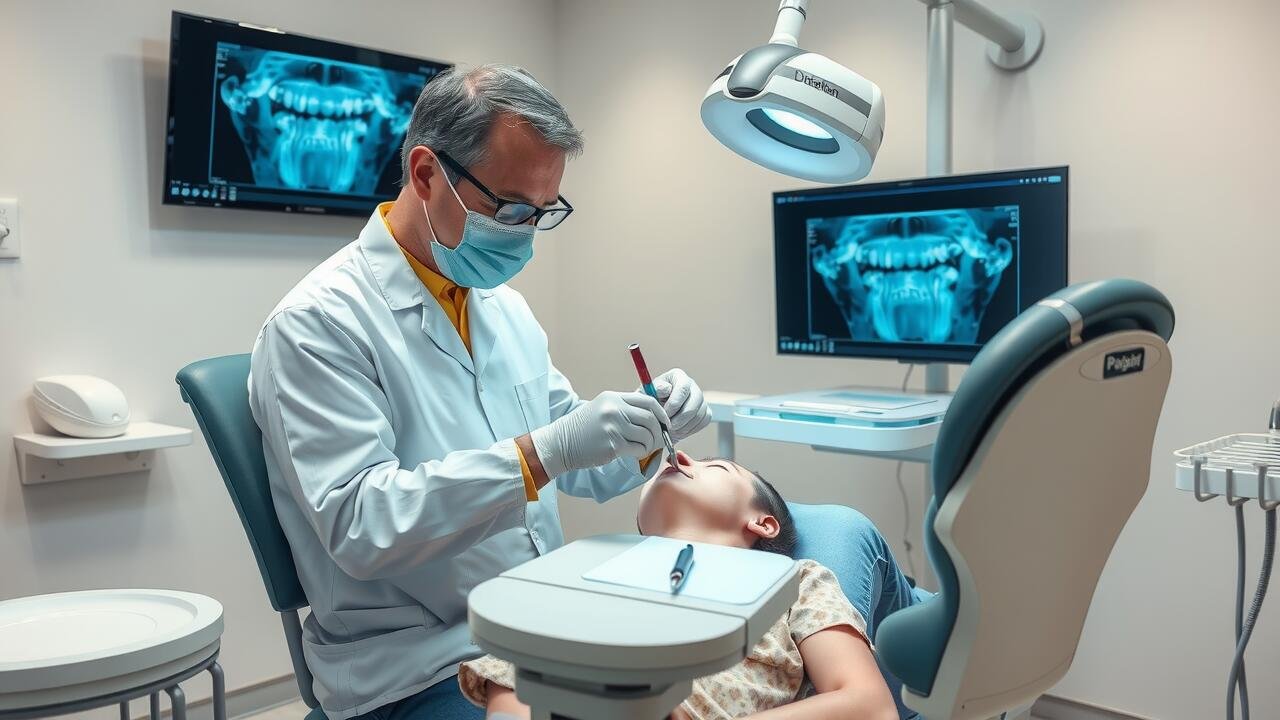Author: John
Long-Term Care for Dental Implants
Taking care of dental implants involves more than just regular check-ups with your dentist. Daily oral hygiene is crucial, including brushing and flossing to remove plaque buildup around the implant site. Patients should also consider using an antimicrobial mouthwash to enhance their cleaning routine. Regular visits to dental professionals are essential, ensuring that the implants remain in optimal condition and identifying any concerns early.
When searching for support, many individuals often type “Dental Implants near me” to find nearby specialists. Selecting a qualified dental professional plays an important role in the long-term success of the implants. A practitioner with experience and positive reviews can provide guidance tailored to individual needs. Knowledgeable support will contribute significantly to maintaining the health and longevity of dental implants.
Maintenance Tips for Longevity
Proper maintenance of dental implants is crucial for their longevity and functionality. Regular brushing and flossing should become part of your daily routine, as these practices help prevent plaque buildup around the implant site. Additionally, using a non-abrasive toothpaste can preserve the integrity of the implant and surrounding gums. Visiting your dentist for routine check-ups will also aid in monitoring the health of your implants and identifying any potential issues early.
When searching for “Dental Implants near me,” consider the post-operative care offered by the dental professional. Clear guidelines on how to care for your implants should be provided, including dietary recommendations and the importance of maintaining oral hygiene. Staying informed about what to expect during the healing process can greatly enhance the success of your implants. Regular professional cleanings are beneficial in maintaining gum health, which is essential for supporting your dental implants.
Potential Risks and Complications
Dental implants are considered a safe and effective solution for tooth replacement. However, potential risks and complications can arise, such as infection at the implant site or damage to nearby teeth. Osseointegration, the process where the implant fuses with the jawbone, may fail, leading to implant loosening. Additional factors like pre-existing health conditions or smoking can heighten these risks, making it crucial to discuss personal medical history with a dental professional before proceeding.
Patients should be aware of specific warning signs indicating complications, including persistent pain, swelling, or bleeding around the implant area. If these symptoms occur, prompt attention is essential to ensure proper care and management. When searching for “dental implants near me,” consider providers who prioritize thorough consultations and offer post-operative support to minimize potential complications and ensure a successful outcome.
Recognizing Warning Signs
Recognizing warning signs after receiving dental implants is crucial to ensuring their longevity and your ongoing health. Swelling, tenderness, or pain around the implant site can indicate infection or complications. Excessive bleeding or a discharge of pus should prompt immediate attention from your dental professional. Regular check-ups can help catch these issues early, but being attuned to your body can lead to quicker action when problems arise. If you’re searching for solutions, consider looking up “Dental Implants near me” to find qualified professionals.
Another key indicator of potential issues is any significant change in the stability of the implant. If you experience loosening or movement of the implant, this is not normal and requires evaluation. Gums that recede or appear unhealthy around the implant can also signal underlying problems that need addressing. Paying attention to these changes can enhance your experience with dental implants and help maintain a healthy oral environment. For those uncertain about their signs, consulting with a local expert by looking for “Dental Implants near me” can provide clarity and reassurance.
Choosing the Right Dental Professional
Selecting the right dental professional for your dental implant procedure is essential for ensuring a successful outcome. When searching for “Dental Implants near me,” it’s important to consider a dentist’s qualifications and experience. Look for a practitioner who specializes in implant dentistry and has a solid track record of successful procedures. Asking for before-and-after photos can provide valuable insight into their skill level.
In addition to checking credentials, you should evaluate the dental office’s technology and atmosphere. A modern practice equipped with the latest tools can enhance your comfort and improve treatment efficiency. Reading online reviews and seeking referrals from friends or family can also guide your decision-making process. Prioritizing clear communication with your chosen professional will help establish a comfortable rapport throughout your dental implant journey.
Key Qualities to Look For
When searching for a dental professional to handle your dental implants, consider their experience and qualifications. Look for a specialist who has completed additional training in implantology or a related field. A strong portfolio showcasing successful cases provides insight into their expertise. Reviews and testimonials from previous patients often highlight the skill and reliability of the practitioner. Doing a bit of research into their background can help in making an informed decision.
Accessibility is another important quality. Many patients search for “Dental Implants near me” to ensure convenience for routine visits and follow-ups. A local practitioner can provide not just ease of access but also familiarity with the community’s resources and regulations. Taking the time to find someone within reach often leads to a more positive and manageable experience throughout the dental implant process.
FAQS
How long do dental implants typically last?
With proper care and maintenance, dental implants can last 10 to 15 years or even longer. Regular dental check-ups and good oral hygiene are essential for their longevity.
Are dental implants painful to get?
Most patients report minimal discomfort during the dental implant procedure, as it is usually performed under local anesthesia. Post-operative pain can be managed with over-the-counter pain relief medications.
What are common complications associated with dental implants?
Some potential complications include infection, nerve damage, and implant failure. It’s important to follow your dentist’s aftercare instructions to minimize these risks.
How do I know if my dental implant is failing?
Signs of a failing dental implant may include persistent pain, swelling, looseness of the implant, or visible changes to the gum tissue. If you notice any of these symptoms, consult your dental professional immediately.
What should I consider when choosing a dental professional for implants?
Look for a dental professional with specialized training in implantology, a good reputation, and positive patient reviews. It’s also important to ensure they use high-quality materials and follow up with a comprehensive care plan.
Signs That Dental Implants May Need Replacement
Dental implants are a durable solution for tooth replacement, but they can exhibit signs of failure over time. Patients may notice changes such as increased discomfort or pain around the implant site. Swelling or inflammation in the surrounding gums often suggests issues that need addressing. Those experiencing persistent symptoms should not ignore these warning signs, as they may indicate that the implant requires replacement. Seeking professional help is crucial for identifying potential problems before they escalate.
Regular check-ups are vital for the long-term success of dental implants. During these visits, a dentist can assess the condition of the implant and the surrounding tissue. If you find yourself asking, “Where can I find dental implants near me?” it’s essential to choose a provider who specializes in implant dentistry. Their expertise can help monitor the health of the implant and ensure that any issues are promptly addressed, potentially extending the lifespan of the dental restoration.
Recognizing Warning Signs
Patients should stay vigilant for certain symptoms that may indicate a problem with their dental implants. If there is persistent pain or discomfort around the implant area, it could signal an underlying issue that needs attention. Swelling or redness in the gums surrounding the implant is another warning sign. Any mobility or loosening of the implant itself should be reported to a dentist promptly.
Changes in the appearance of the gums, such as receding or discolored tissue, can also be significant. A hidden infection may be present if there are signs of pus or unusual drainage. Regular check-ups can help catch these issues early. For those searching for solutions online, “Dental Implants near me” can lead to local professionals who can conduct assessments and provide necessary treatments.
The Impact of Lifestyle on Dental Implants
The longevity of dental implants can be significantly affected by an individual’s lifestyle choices. Poor dietary habits, such as excessive sugar consumption and a lack of essential nutrients, can negatively impact oral health and the surrounding bone structure. Smoking is another detrimental habit that interferes with healing processes and increases the risk of infection. Patients often overlook how these everyday choices can influence the success of their dental implants.
Regular dental care and maintenance also play a crucial role in the durability of implants. Finding a professional who offers “Dental Implants near me” can make routine check-ups more manageable. Adhering to proper oral hygiene practices, coupled with periodic evaluations by a dentist, helps detect any issues early. This proactive approach can prevent complications and extend the life of the implants significantly.
How Diet and Habits Influence Longevity
Diet and lifestyle choices greatly affect the longevity of dental implants. A balanced diet rich in nutrients supports overall oral health, which, in turn, benefits dental implants. Foods high in sugar can lead to plaque buildup and gum disease, jeopardizing the stability of implants. Drinking plenty of water and consuming crunchy vegetables can help maintain oral hygiene, which is crucial for implants to thrive.
Additionally, habits such as smoking and excessive alcohol consumption can undermine the success of dental implants. Smoking inhibits blood flow to the gums, increasing the risk of complications. Individuals searching for dental implants near me should consider how their lifestyle might impact their investment. Making healthier choices can lead to improved longevity and better outcomes for dental implants.
The Role of the Dentist
Regular visits to the dentist play a crucial role in ensuring the longevity of dental implants. Professional check-ups allow for early detection of any potential issues that could affect the integrity of the implants. Dentists can evaluate the health of surrounding gums and bone structure, addressing any signs of infection or inflammation as they arise. This proactive approach not only helps maintain the functionality of the implants but also contributes to overall oral health.
When searching for “Dental Implants near me,” finding a qualified dentist with experience in implant dentistry is essential. An experienced professional will have the skills to manage post-operative care and will offer personalized guidance tailored to each patient’s specific needs. Frequent follow-ups can lead to timely interventions, ensuring that any minor complications are handled before they develop into significant concerns. Ultimately, a collaborative relationship with a trusted dentist can make a significant difference in the lifespan of dental implants.
Importance of Professional Check-Ups
Regular professional check-ups are crucial for maintaining the health and longevity of dental implants. During these visits, dentists can assess the condition of the implants, gums, and surrounding teeth. They look for any signs of infection, inflammation, or bone loss that could compromise the stability of the implants. Addressing these issues early can prevent more significant problems down the line.
Finding “Dental Implants near me” ensures that you have access to skilled professionals who can provide necessary examinations and cleanings. These appointments typically include imaging tests to monitor the integrity of the implants and surrounding bone structure. Consistent dental visits help in maintaining optimal oral hygiene and ensuring that your implants stay in excellent condition for many years.
FAQS
How long do dental implants typically last?
Dental implants can last anywhere from 10 to 15 years, and with proper care, many can last even longer.
What factors can affect the longevity of dental implants?
Factors such as oral hygiene, lifestyle choices, diet, and regular dental check-ups can significantly influence the lifespan of dental implants.
Are there signs that indicate a dental implant may need replacement?
Yes, warning signs include pain, swelling, changes in the gum tissue around the implant, and mobility of the implant itself.
How does diet impact the lifespan of dental implants?
A diet high in sugars and acidic foods can lead to gum disease and other oral health issues, which may negatively affect the longevity of dental implants.
Why are professional dental check-ups important for maintaining dental implants?
Regular check-ups allow dentists to monitor the condition of the implants, identify potential issues early, and provide necessary treatments to ensure the longevity of the implants.
Possible Discomfort
Many individuals experience some level of discomfort following the dental implant procedure. This discomfort can stem from the surgical process, which may involve incision and manipulation of gum tissue as well as the underlying bone. In the days following the surgery, patients often report pain and tenderness in the affected area. Over-the-counter pain relief medications are commonly recommended to help manage this discomfort. Dentists in places like Dental Implants Costa Mesa, California, often provide detailed aftercare instructions to minimize any potential pain during the recovery period.
Sensitivity can also be a concern in the aftermath of receiving dental implants. The newly placed implants and surrounding gums may react to temperature changes, leading to heightened sensitivity. Some individuals may find that their bite feels different initially, which can contribute to discomfort while chewing. Conversations with dental professionals in Dental Implants Costa Mesa, California, can offer guidance on how to cope with these sensations and ensure a smoother healing process.
Pain and Sensitivity
Patients often experience some pain and sensitivity following the dental implant procedure. This discomfort can manifest immediately after surgery or may develop over a few days as the area heals. While it’s common to encounter some level of sensitivity, especially when pressure is applied, most individuals find that this symptom subsides within a few weeks. Proper aftercare and adherence to post-operative instructions provided by practitioners play a significant role in managing this discomfort.
In Newport Beach, California, professionals recommend that patients keep an eye on their pain levels. If discomfort persists or worsens beyond the typical recovery timeframe, it may be necessary to consult a dental specialist. Undue pain could indicate complications, such as issues with the implant itself or surrounding tissues. Prompt evaluation ensures that any potential problems can be addressed swiftly, promoting optimal healing and comfort during the recovery process.
Bone Integration Issues
Bone integration is a crucial aspect of the success of dental implants. The implant relies on the surrounding bone to achieve stability, a process known as osseointegration. If the bone does not adequately fuse with the implant, it can lead to complications. Factors such as insufficient bone density, infection, or improper implant placement may contribute to these issues. Patients seeking Dental Implants Anaheim, California, should understand the need for thorough planning and evaluation before the procedure to minimize these risks.
Furthermore, bone integration problems can result in implant mobility or even failure, leading to the need for additional surgeries or bone grafts. Patients may find that their initial hopes for improved oral function and aesthetics are dashed if the implant does not integrate properly. It is essential for individuals to discuss any concerns with their dental professional, as understanding the implications of bone integration can help set realistic expectations for the success of their implants.
Failure to Fuse
Failure to fuse, or the lack of proper integration with the jawbone, is a significant concern associated with dental implants. When osseointegration does not occur, the implant may become loose or fail entirely, leading to complications and the potential need for removal. Factors affecting this integration process include insufficient bone density, infection, and poor dental hygiene. A dental professional will often evaluate these aspects before recommending implants.
In areas like Dental Implants Costa Mesa, California, practitioners emphasize the importance of thorough assessments to minimize the risk of failure. Patients are encouraged to follow post-operative care instructions diligently and maintain regular check-ups. Having an experienced team can also help ensure a higher success rate in achieving proper fusion, thus enhancing the longevity of the implants.
Aesthetic Concerns
Dental implants can sometimes create aesthetic concerns, especially when the color and shape of the implant do not match the surrounding teeth. This mismatch can detract from a natural smile and may lead to dissatisfaction with the final results. Patients seeking solutions like Dental Implants Santa Ana, California, often want to achieve optimal blending with their existing teeth, which can be a challenge if the implant does not integrate well visually.
Another issue arises with the gum tissue surrounding the implant. In some cases, the gum might not heal properly or may recede, revealing the metal post or affecting the overall appearance of the smile. Those considering Dental Implants Santa Ana, California, should be aware of the importance of matching not just the implant itself but also ensuring that the surrounding soft tissue looks healthy and natural. Aesthetic outcomes rely heavily on careful planning and execution by skilled dental professionals.
Mismatched Appearance
Dental implants offer the benefit of restoring smiles, but achieving a natural appearance can be challenging. Sometimes, implants may not align perfectly with existing teeth in terms of color, shape, or size. This mismatch can become noticeable, affecting the overall aesthetics of a person’s smile. Patients seeking dental implants must consider the potential for these discrepancies when planning their treatment.
In areas like Newport Beach, California, where aesthetics play a significant role in daily life, this concern becomes even more pertinent. Dental professionals emphasize the importance of customizing implants to match the unique characteristics of a patient’s natural teeth. This careful consideration can help mitigate aesthetic issues and enhance the success of the treatment.
FAQS
What are the common downsides of dental implants?
Common downsides of dental implants include possible discomfort, bone integration issues, and aesthetic concerns, such as a mismatched appearance with natural teeth.
Is pain and sensitivity a common issue after dental implant surgery?
Yes, some patients may experience pain and sensitivity in the implant area during the healing process, although this usually subsides over time.
What happens if a dental implant fails to fuse with the bone?
If a dental implant fails to fuse with the bone, it may lead to implant failure, requiring removal and possibly additional treatments before a new implant can be placed.
Can dental implants look unnatural?
Yes, if the color or shape of the dental implant does not match the surrounding teeth, it can create an aesthetic concern, making the implant look unnatural.
How can I minimize discomfort after getting a dental implant?
To minimize discomfort after getting a dental implant, follow your dentist’s post-operative care instructions, take prescribed medications, and maintain good oral hygiene to promote healing.
Maintenance Tips After Whitening
After undergoing a teeth whitening treatment, maintaining your results is essential for a long-lasting bright smile. Regular brushing and flossing, along with using toothpaste designed for sensitive teeth, can help preserve the effects of whitening. It is also advisable to limit the intake of staining foods and beverages, such as coffee, red wine, and berries. Incorporating a straw when drinking can minimize contact with the teeth, further contributing to the upkeep of your results.
For those seeking services in the area, Teeth Whitening Irvine, California, offers various options tailored to individual needs. Scheduling follow-up treatments or touch-ups can be beneficial for maintaining your desired shade. Additionally, routine dental check-ups should not be overlooked, as they provide professional cleanings that can enhance and prolong your whitening effects while ensuring overall dental health.
Keeping Your Smile Bright
After undergoing a teeth whitening treatment, maintaining that bright smile becomes essential. Regular dental hygiene is crucial. This includes brushing at least twice a day and flossing to prevent plaque buildup. The foods and beverages consumed also play a role in the longevity of the whitening effects. Reducing intake of staining substances like coffee, red wine, and dark berries can be beneficial.
Incorporating whitening toothpaste into your routine can help sustain the brightness of your teeth. Many people opt for follow-up treatments to ensure their results last longer. For those seeking professional assistance, Teeth Whitening California offers various options tailored to individual needs. Regular check-ups with a dentist can also help monitor the condition of your teeth and guide you in maintaining your dazzling smile.
Safety Considerations for Teeth Whitening
Teeth whitening procedures, while generally safe, require careful consideration of individual dental health. Consulting with a dental professional before undergoing any whitening treatment is crucial. They can assess your oral health and recommend suitable options that align with your needs. In cities like Irvine, California, many dentists understand the specific requirements for effective and safe whitening, allowing patients to make informed choices.
It is essential to be aware of potential side effects, such as tooth sensitivity or gum irritation. Ensuring that the whitening method used is appropriate for your teeth helps to minimize these risks. Additionally, following aftercare instructions can enhance results while protecting your enamel. Residents of Irvine, California, seeking to brighten their smiles should prioritize safety and professional guidance during their whitening journey.
Avoiding Damage to Enamel
Teeth whitening treatments can sometimes pose a risk to enamel if not performed correctly. It’s crucial to choose methods that are gentle yet effective. Many patients seek services like Teeth Whitening Irvine, California, where professionals ensure the right approach tailored to individual dental health. Following manufacturer instructions and consulting with dental specialists can also help safeguard enamel during the whitening process.
Another important factor is the frequency of treatments. Overusing whitening products, especially those containing strong bleaching agents, can lead to increased tooth sensitivity and enamel erosion. Opting for professional services can mitigate these risks, providing an optimal balance between achieving a brighter smile and maintaining enamel integrity. Regular check-ups after treatment further support enamel health and monitor any changes that may arise.
Common Myths About Teeth Whitening
Many people hold misconceptions about teeth whitening that can lead to misunderstandings about the process. One common myth is that all whitening treatments are equally effective. The reality is that results can vary significantly based on the method used, whether it’s in-office treatments or at-home products. Professional services in places like Teeth Whitening Irvine, California, often yield quicker and more noticeable results due to the higher concentrations of active ingredients used by dental professionals.
Another prevalent myth is that teeth whitening damages enamel. While it is true that some aggressive treatments can cause sensitivity, proper whitening procedures, especially those supervised by a dentist, are designed to be safe for enamel. Individuals considering whitening should look for reputable sources and professional recommendations, particularly those available in Teeth Whitening Irvine, California, to ensure they make informed choices that prioritize their dental health.
Debunking Misconceptions
Many people believe that over-the-counter teeth whitening products are just as effective as professional treatments. This misconception often leads to frustration when expected results aren’t achieved. While at-home kits can produce some improvement, they typically lack the potency and formulation found in professional options. In areas like Teeth Whitening Irvine, California, dental professionals utilize advanced techniques and stronger agents that can yield significant and faster results.
Another common myth is that teeth whitening is harmful to dental health. Many are concerned that the process may damage enamel or cause sensitivity. However, when conducted properly by a trained professional, whitening treatments are safe for most individuals. Dentists in places like Teeth Whitening Irvine, California, assess individual cases to ensure that patients can benefit from the procedure without compromising their dental health.
FAQS
How many sessions are typically required to achieve noticeable teeth whitening results?
Most people see noticeable results after 2 to 3 sessions, but the exact number can vary depending on the method used and the initial shade of your teeth.
Can I whiten my teeth in just one session?
Yes, some professional whitening treatments can achieve significant results in just one session, but multiple sessions may be needed for optimal brightness.
How long do the effects of teeth whitening last?
The effects can last from several months to a few years, depending on factors like diet, oral hygiene, and whether you smoke or consume staining substances.
Is it safe to have multiple teeth whitening sessions in a short period?
It’s generally recommended to wait at least a few weeks between sessions to allow your teeth and gums to recover, but you should always consult with your dentist for personalized advice.
Do at-home whitening kits require the same number of sessions as professional treatments?
At-home whitening kits often require more sessions to achieve similar results as professional treatments since they typically contain lower concentrations of whitening agents.
Patient Considerations
When considering dental implants, patients must assess several factors that influence their overall eligibility and success rate. Individual health history plays a crucial role, including the presence of chronic conditions such as diabetes or heart disease which may complicate the healing process. The quality and quantity of the jawbone also determine the feasibility of the procedure. For those in regions like Dental Implants Costa Mesa, California, local specialists often evaluate these aspects thoroughly during initial consultations to create tailored treatment plans.
Patient habits, particularly smoking and oral hygiene practices, significantly impact the longevity of dental implants. Smokers may face increased risks of complications and implant failures. Maintaining optimal oral hygiene is essential in ensuring the long-term success of the implants. As local dental professionals in areas such as Dental Implants Costa Mesa, California emphasize, educating patients about their responsibilities post-surgery can improve outcomes. Addressing these considerations early in the planning stages can lead to a more successful treatment experience.
How the Rule Affects Treatment Plans
The 3/2 rule significantly influences the treatment planning process for dental implants. This guideline dictates that for every three millimeters of bone height available, the clinician should plan for two millimeters of implant length. Such a framework ensures that the implant is adequately anchored within the jawbone, promoting long-term stability and success. In areas like Dental Implants Costa Mesa, California, practitioners utilize this rule to tailor each implant plan to the individual patient’s anatomical conditions, ensuring optimal results.
Incorporating the 3/2 rule into treatment planning requires careful consideration of the patient’s specific needs. Factors such as bone quality, density, and existing anatomical structures must align with the rule’s recommendations. By adhering to this guideline, practitioners in Dental Implants Costa Mesa, California, can provide focused and personalized treatment options. This approach helps in achieving a balance between implant size and available bone, which can significantly affect the overall outcome and durability of the implant.
Comparing with Other Guidelines
The 3/2 rule offers a framework that balances safety and efficiency in dental implant procedures. Other protocols may emphasize different factors, such as bone density or specific implant types, which can influence both the surgical approach and overall treatment plans. In contrast, the 3/2 rule focuses on the ratio of the number of teeth lost to the number of dental implants placed. This ratio can optimize results while ensuring patient comfort and minimizing complications.
In the realm of dental implants, Costa Mesa, California, practitioners often utilize a mix of guidelines to tailor their approaches based on individual patient needs. While the 3/2 rule serves as a practical foundation, many clinicians also consider additional factors such as the spacing of implants and the location of bone. These considerations can lead to variations in the implementation of the 3/2 rule, offering a more personalized treatment pathway for patients seeking dental solutions.
The 3/2 Rule vs. Other Implant Protocols
The 3/2 rule provides a unique framework for determining the optimal timing and integration of dental implants. This method contrasts with traditional protocols, which often emphasize a more standardized healing period and lack the flexibility found in the 3/2 rule. Many professionals in the field of dental implants are exploring how this rule can enhance patient outcomes by tailoring treatment plans more closely to individual circumstances. Practices in areas like Dental Implants Costa Mesa, California, are increasingly adopting this approach, aiming to improve the efficiency and effectiveness of implant procedures.
Other guidelines, such as immediate implant placement or delayed loading strategies, can differ significantly from the 3/2 rule. Immediate placement protocols allow for implants to be inserted right after tooth extraction, while delayed loading puts emphasis on allowing the bone to heal before any load is applied. The 3/2 rule navigates between these approaches, providing a middle ground that can cater to diverse patient needs. This adaptability is particularly evident in regions committed to optimizing care and achieving lasting results in the field of dental implants.
Case Studies and Examples
In a clinical setting in Santa Ana, California, a patient presented with a considerable edentulous area in the lower jaw. Applying the 3/2 rule, the dental team determined that for every two teeth missing, three units of restoration would be necessary, ensuring optimal spacing and support for the dental implants. This approach not only provided adequate mechanical strength but also enhanced the aesthetic outcome of the final restoration.
Another case study involved a patient looking for dental implants to replace multiple missing teeth. The practitioners utilized the 3/2 rule, allowing them to calculate appropriate implant placement based on the available bone and the anatomy of the patient’s mouth. This structured method facilitated a smoother treatment plan, ultimately leading to successful outcomes for the patient while minimizing risks associated with inadequate support structures for the implants.
Real-Life Applications of the Rule
The 3/2 rule is often applied in various clinical scenarios involving dental implants, particularly in the California region. Practitioners frequently use this guideline to determine the ideal spacing and angulation of implants. For example, when placing two implants, the distance between their centers should be at least three times the diameter of the implant fixtures. This approach helps in maintaining bone quality and ensures that each implant has enough support from the surrounding structures, reducing the risk of complications.
In practice, many dental professionals implementing the 3/2 rule have reported improved outcomes in their patients. The rule aids in preparing comprehensive treatment plans, accommodating individual patient anatomy and bone density. Clinics specializing in dental implants California have observed positive results, including enhanced stability of the implants and better aesthetic outcomes. By following this guideline, practitioners can efficiently manage patients’ expectations and deliver effective results in restorative dentistry.
FAQS
What is the 3/2 rule for dental implants?
The 3/2 rule is a guideline used in dental implantology that suggests that for every three millimeters of bone height, there should be at least two millimeters of bone width to ensure successful implant placement and stability.
How does the 3/2 rule impact treatment plans for dental implants?
The 3/2 rule helps dentists assess whether a patient has sufficient bone structure to support an implant. If the bone dimensions do not meet this guideline, additional procedures such as bone grafting may be necessary before implant placement.
Are there other guidelines similar to the 3/2 rule for dental implants?
Yes, there are various implant protocols and guidelines, such as the 1:1 rule and the use of advanced imaging techniques, that also consider bone quantity and quality. However, the 3/2 rule is specifically focused on the proportion of bone height to width.
What are some real-life applications of the 3/2 rule in dental practice?
Dentists may use the 3/2 rule during initial assessments to determine the feasibility of implant placement. It can also guide decisions on whether to proceed with immediate implant placement or to take additional steps to enhance bone structure.
Can patients with insufficient bone volume still receive dental implants?
Yes, patients with insufficient bone volume may still be candidates for dental implants by utilizing options such as bone grafting, sinus lifts, or using shorter implants, depending on their specific situation and the dentist’s assessment.
Comparing Whitening Toothpastes
Whitening toothpastes are among the most accessible options for those looking to enhance their smile. Many of these products contain mild abrasives and chemical agents that can help remove surface stains from the teeth. When searching for such options, consumers often input “Teeth Whitening near me” into their search engines, hoping to find local products or recommendations for effective brands. Each toothpaste may have varying active ingredients, making it essential to read labels carefully to find one that suits specific needs.
The effectiveness of whitening toothpastes can vary widely. While some claim to produce visible results in a matter of days, others may take much longer or show minimal improvement. Over-the-counter options typically contain lower concentrations of whitening agents compared to professional treatments, which might lead to a more gradual change. Users should also consider their overall dental health before relying solely on these products for significant whitening effects.
Active Ingredients and Their Effects
Whitening toothpastes typically contain active ingredients such as hydrogen peroxide, carbamide peroxide, or baking soda. These compounds work to lift stains and brighten the enamel. Hydrogen peroxide is especially effective due to its ability to penetrate the enamel and break down deeper stains. Carbamide peroxide acts as a slower-releasing option, allowing for longer contact with the teeth. Baking soda, a natural abrasive, helps to scrub surface stains while also providing a mild whitening effect.
When searching for options like “Teeth Whitening near me,” it’s essential to consider the concentration of these ingredients. Higher concentrations often yield faster results but may cause sensitivity or irritation in some users. Products should be chosen based on individual tolerance and desired outcomes. Over-the-counter options may be suitable for mild discoloration, while professional treatments might be necessary for more significant whitening challenges. Understanding the active ingredients helps in making an informed choice in the whitening process.
The Role of Laser Whitening
Laser whitening is a popular option for those seeking quick and noticeable results when brightening their smiles. This procedure utilizes focused light energy to activate a whitening gel applied to the teeth. The heat generated by the laser enhances the gel’s effectiveness, often resulting in multiple shades brighter teeth in just one session. Many dental clinics offer comprehensive packages that include pre-treatment assessments to ensure optimal outcomes.
Choosing laser whitening can be an excellent investment in your oral aesthetics. While some may find this method more expensive than traditional treatments, the convenience and immediate results can justify the cost for many. When searching for “Teeth Whitening near me,” it’s essential to consider clinics with experienced professionals who utilize state-of-the-art equipment to achieve the best results. This ensures safety during the process and increases the likelihood of long-lasting brightness.
What to Expect During the Procedure
During a laser whitening procedure, patients can expect a relatively quick and efficient treatment session. The process typically begins with the application of a protective barrier to the gums to minimize sensitivity. Once that is in place, a whitening gel containing hydrogen peroxide is applied to the teeth. A laser is then used to activate the gel, enhancing its effectiveness in breaking down stains and discoloration. This method usually takes around an hour, making it a convenient option for those seeking immediate results.
Post-treatment, individuals may experience some sensitivity temporarily, which is a normal occurrence. It is essential to follow any aftercare instructions provided by the dental professional to maintain the results. For those considering this procedure, searching for “Teeth Whitening near me” can help in finding qualified professionals who offer laser whitening services. Many clinics provide consultations to discuss expectations and any specific concerns patients may have during the treatment process.
Maintenance After Whitening
After undergoing any teeth whitening treatment, proper maintenance is essential to prolong the results. Regular dental hygiene practices, such as brushing twice a day and flossing daily, help keep your teeth clean and may enhance the longevity of the whitening effect. Additionally, certain dietary choices can impact the brightness of your smile. Avoiding or limiting consumption of staining foods and beverages, such as coffee, red wine, and dark berries, can help maintain your new shade.
If you’re looking for ongoing support or solutions for any discoloration that may occur over time, consider searching for “Teeth Whitening near me.” Many dental clinics offer maintenance treatments or touch-ups that can refresh your smile periodically. It is also beneficial to speak with your dentist about suitable at-home products that can aid in preserving your results without causing harm to your enamel.
Tips for Prolonging Results
Maintaining the brightness of your smile after a teeth whitening treatment requires diligence. To extend the longevity of your results, consider changing certain habits. Reduce the intake of teeth-staining foods and beverages such as coffee, red wine, and dark-colored sauces. Additionally, maintaining a consistent oral hygiene routine plays a crucial role. Regular brushing with a soft-bristled toothbrush and fluoride toothpaste can help minimize discoloration.
Regular dental check-ups and cleanings are also essential for upkeep. Professionals can remove surface stains that accumulate over time, ensuring your smile remains vibrant. If you are unsure about the best products to use or how to care for your smile post-whitening, searching for “Teeth Whitening near me” can connect you with local experts. They can provide personalized advice and recommend maintenance products to keep your teeth looking their best.
FAQS
What are the most common types of teeth whitening?
The most common types of teeth whitening include whitening toothpastes, over-the-counter whitening strips, professional in-office treatments, and at-home whitening kits provided by dentists.
How do whitening toothpastes work?
Whitening toothpastes generally contain mild abrasives and chemical agents that help remove surface stains from teeth. However, they typically do not change the natural color of teeth as significantly as other whitening methods.
Is laser whitening effective for all types of stains?
Laser whitening is most effective for extrinsic stains, which are caused by food, drinks, and habits like smoking. It may be less effective for intrinsic stains, which originate from within the tooth due to factors like aging or trauma.
How long do the results from laser whitening last?
The results from laser whitening can last anywhere from six months to two years, depending on personal habits, oral hygiene, and diet. Regular maintenance can help prolong the effects.
What are some tips for maintaining teeth whiteness after treatment?
To maintain teeth whiteness, avoid foods and drinks that can cause staining, practice good oral hygiene, use a straw for beverages that stain, and consider using whitening toothpaste or touch-up kits as recommended by your dentist.
Maintenance and Care
Proper maintenance and care are crucial for the longevity of dental implants. Regular brushing and flossing are essential to keep the implant and the surrounding gum tissue healthy. Many dental professionals recommend using a soft-bristled toothbrush and non-abrasive toothpaste to avoid damaging the surface of the implant. Scheduling routine dental check-ups ensures that any potential issues are addressed promptly. Finding “Dental Implants near me” can help ensure access to professionals who specialize in the care of these restorations.
In addition to at-home care, the dietary choices one makes can also impact the health of dental implants. Hard or sticky foods may pose a risk of damaging both the implant and surrounding teeth. Maintaining a balanced diet that supports oral health while avoiding harmful habits, such as teeth grinding, plays a significant role in the longevity of the implants. Regular consultations with your dentist can provide additional insights on how to care for your implants effectively.
Keeping Your Implants in Optimal Condition
Maintaining dental implants requires a commitment to good oral hygiene. Regular brushing and flossing are essential to prevent plaque buildup around implants. Utilizing specific tools like implant-friendly toothbrushes can enhance the cleaning process. Routine dental check-ups are also vital for monitoring the health of both the implants and surrounding tissues. Dentists can provide personalized advice tailored to individual needs.
Choosing qualified providers for dental implants near me can also affect long-term success. Ensuring that the procedure is performed by an experienced professional minimizes post-operative complications. Additionally, proper care following the placement of the implants aids in their longevity. Adhering to guidelines provided by your dentist can contribute significantly to keeping your implants in optimal condition.
Time Commitment
The process of getting dental implants requires a significant time commitment. Initially, patients need to undergo a thorough evaluation, which includes imaging studies and consultations with specialists. Following this, the surgical procedure itself can take several hours, depending on the number of implants being placed. Healing time can vary as well, often requiring a few months before the implants fully integrate with the jawbone.
After the healing phase, additional appointments will be necessary for placing the abutment and final crown. Many patients may find this timeline challenging, especially if multiple visits are involved. Those considering the procedure may benefit from searching for “Dental Implants near me” to ensure convenient access to specialists and reduce overall travel time for appointments.
How Long Does the Entire Process Take?
The full dental implant process typically spans several months from the initial consultation to final restoration. After the first appointment, which includes a thorough assessment and imaging, the surgical placement of the implant occurs. This part of the process may take about one to two hours depending on the complexity of the case. However, healing time can extend from three to six months as the jawbone fuses with the implant through osseointegration.
Once the healing is complete, patients can return to the dental office for abutment placement and impressions for the crown. The final restoration can take an additional couple of weeks. Those searching for “Dental Implants near me” may find that local clinics provide clear timelines during initial consultations, leading to a better understanding of what to expect throughout the procedure. Each individual’s experience will vary based on personal health and specific dental situations.
Impact on Oral Health
Dental implants can significantly impact oral health, particularly when it comes to the surrounding teeth. When a tooth is missing, the neighboring teeth may shift into the space over time. This movement can lead to misalignment and additional dental issues. By opting for dental implants, patients effectively fill in the gaps, helping maintain the proper alignment of their teeth and preventing further complications.
Finding “Dental Implants near me” can ensure that individuals receive quality care for their dental needs. Skilled professionals can evaluate the condition of the surrounding teeth before proceeding with implants. This evaluation allows for personalized treatment plans that promote long-term oral health, emphasizing the importance of maintaining a strong and balanced bite.
Can Implants Affect Surrounding Teeth?
Dental implants can indeed impact the surrounding teeth, primarily through the way they interact with the existing dental structure. When an implant is inserted, it requires the support of the surrounding bone and gum tissue. If not properly aligned, an implant can place undue stress on neighboring teeth, leading to potential long-term complications. Misalignment can result in issues such as shifting of adjacent teeth or even gum recession, which highlights the importance of choosing a qualified professional for the procedure.
Patients considering dental implants often search for “Dental Implants near me” to find local specialists who can help ensure proper placement. Regular consultations and follow-ups with the dentist are crucial in monitoring the health of both the implants and the surrounding teeth. Early intervention can prevent many issues that may arise, ensuring that the overall integrity of a patient’s dental health remains intact.
FAQS
What are the potential downsides of dental implants?
Some potential downsides of dental implants include the risk of infection, the need for surgery, possible damage to surrounding teeth, and the time required for the healing process.
How can I maintain my dental implants effectively?
To maintain dental implants effectively, practice good oral hygiene by brushing and flossing daily, visit your dentist regularly for check-ups, and avoid hard foods that could damage the implants.
How long does the dental implant process usually take?
The dental implant process can vary, but it typically takes several months from the initial consultation to the final placement of the crown, including time for healing and osseointegration.
Can dental implants affect my oral health negatively?
While dental implants can improve oral health by providing stability and preventing bone loss, improper placement or maintenance can lead to issues such as gum disease or damage to adjacent teeth.
Are dental implants suitable for everyone?
Dental implants may not be suitable for everyone, particularly individuals with certain health conditions, insufficient bone density, or those who smoke. A thorough evaluation by a dental professional is essential to determine candidacy for implants.
Lifestyle Changes to Improve Teeth Color
Making lifestyle changes can significantly enhance the brightness of your teeth. Regular oral hygiene practices, such as brushing twice daily and flossing, play a crucial role in maintaining a white smile. Incorporating whitening toothpaste into your routine can also help reduce stains. Regular dental check-ups provide an opportunity for professional cleanings, which can remove tartar and surface stains that at-home care might miss.
Dietary choices directly impact tooth color. Certain beverages, like coffee, tea, and red wine, are known for their staining properties. Cutting back on these can help prevent further discoloration. Additionally, consuming crunchy fruits and vegetables, such as apples and carrots, can naturally clean teeth while promoting healthy gums. If you’re in search of professional assistance, options like Teeth Whitening Newport Beach, California, can offer tailored solutions to restore your smile’s brilliance.
Foods and Habits to Avoid
Certain foods and habits can greatly contribute to the discoloration of teeth. Regular consumption of staining beverages like coffee, tea, and red wine can lead to noticeable yellowing. Foods high in acidity, such as citrus fruits and sodas, can also erode tooth enamel, making teeth more prone to staining. To maintain a brighter smile, it is important to limit these items in your diet.
Smoking is another significant factor that detracts from the whiteness of teeth. The tar and nicotine found in tobacco products lead to deep stains that can be difficult to remove. For those seeking professional solutions, consulting with dental specialists in teeth whitening in Anaheim, California, can provide effective treatments to counteract the effects of these habits. Additionally, practicing good oral hygiene can go a long way in preserving the results of any whitening treatments.
The Impact of Age on Teeth Color
As people age, the natural wear and tear on tooth enamel can lead to noticeable changes in the color of teeth. Enamel, the outermost layer of a tooth, gradually becomes thinner over time, making the underlying dentin more visible. This dentin has a yellower hue, which can contribute to the overall appearance of teeth that seem less vibrant or even discolored. Factors such as diet, oral hygiene, and exposure to substances like tobacco or acidic foods can accelerate this process.
Teeth Whitening California offers various treatments tailored to counteract these age-related changes. Professional whitening solutions can effectively target deep-set stains that might accumulate over years. Many individuals seek these treatments not only for cosmetic reasons but also to regain confidence in their smiles, showcasing the impact that aging has on self-image. Regular maintenance and good dental habits can enhance the longevity of these whitening treatments.
How Aging Affects Tooth Enamel
As people age, their tooth enamel naturally begins to thin. This thinning exposes the underlying dentin, which is darker in color, leading to a yellowish appearance of the teeth. In addition, the cumulative effects of regular wear and tear over the years can contribute to discoloration. Factors such as dietary choices and oral hygiene practices play a significant role in this process, altering the overall aesthetic of one’s smile.
The decline in enamel quality can also heighten sensitivity to hot and cold substances. Those experiencing changes in their teeth may seek various solutions, including professional treatments like Teeth Whitening Santa Ana, California. Consistent maintenance and proper care can help in managing the effects of aging, ensuring that teeth remain as bright and healthy as possible.
Maintaining Whitened Teeth
After achieving a brighter smile through teeth whitening, it’s essential to adopt a routine that preserves those results. Regular dental check-ups play a crucial role in maintaining the appearance of white teeth. Professional cleanings can help remove surface stains and tartar buildup that might dull the shine of whitened teeth.
Diet also significantly influences the longevity of whitening effects. Reducing the consumption of stain-causing foods and beverages can help keep teeth looking bright. People in the area can look for services like Teeth Whitening Santa Ana, California, which often provide at-home maintenance kits and advice tailored to individual needs, guiding them in maintaining their beautiful smiles over time.
Tips for Long-lasting Results
Maintaining the brightness of your teeth after a whitening treatment requires a consistent oral hygiene routine. Daily brushing and flossing help remove plaque and prevent stains from setting in. The use of a whitening toothpaste can also provide an extra boost, keeping your smile vibrant between professional treatments. Regular visits to your dentist for cleanings are essential as they can help maintain the overall health and appearance of your teeth. Residents of Teeth Whitening Irvine, California, often benefit from tailored advice that addresses local lifestyle factors.
Limiting the consumption of stain-causing foods and beverages can significantly impact how long your results last. Beverages like coffee, tea, and red wine, as well as foods such as berries and sauces, can contribute to discoloration over time. Using a straw when consuming these beverages can reduce contact with your teeth. Additionally, quitting tobacco products is crucial, as they are notorious for staining teeth. Those living in Teeth Whitening Irvine, California, have access to various resources that can help them avoid habits that lead to discoloration, ensuring a brilliant smile.
FAQS
Can yellow teeth really become white again?
Yes, yellow teeth can become white again through various methods such as professional whitening treatments, at-home whitening products, and lifestyle changes that promote better oral hygiene.
What lifestyle changes can help improve the color of my teeth?
Lifestyle changes include reducing the consumption of stain-causing foods and beverages, quitting smoking, maintaining a proper oral hygiene routine, and regularly visiting your dentist for cleanings.
Are there specific foods or habits I should avoid to prevent further yellowing of my teeth?
Yes, you should limit foods and drinks that can stain your teeth, such as coffee, tea, red wine, and dark berries. Additionally, avoiding tobacco products can significantly help maintain a whiter smile.
How does aging affect the color of my teeth?
As you age, the enamel on your teeth can wear down, revealing the yellowish dentin underneath. This natural aging process can lead to a darker appearance of your teeth over time.
What tips can I follow to maintain my whitened teeth after treatment?
To maintain whitened teeth, continue practicing good oral hygiene, avoid foods and beverages that stain, use a straw when drinking, and consider touch-up treatments as recommended by your dentist.
Recommended Methods for Whitening Teeth with Baking Soda
Baking soda has gained popularity for its potential to whiten teeth due to its mild abrasive properties. To effectively use baking soda for this purpose, one common approach is creating a simple paste. This can be done by mixing two tablespoons of baking soda with a small amount of water until it achieves a paste-like consistency. The mixture can be gently applied to the toothbrush and used to brush the teeth for about two minutes. This method can be incorporated into an occasional oral care routine to help reduce surface stains.
Many consider the benefits of baking soda when looking for natural teeth whitening options. In regions like California, where many seek brighter smiles, baking soda can be a convenient option. It is essential to combine this method with regular dental hygiene practices to maintain overall oral health. Ensuring that the baking soda is not used excessively is crucial, as overuse may lead to enamel erosion. Balancing the need for whiter teeth with proper dental care can be achieved through the thoughtful application of these methods.
DIY Paste Recipes for Safe Application
Creating a safe and effective DIY baking soda paste for teeth whitening can be straightforward. Combine one part baking soda with two parts water to form a thick paste. This mixture should be applied gently to your toothbrush and used to scrub your teeth for about two minutes. For added flavor and benefits, consider mixing in a drop of peppermint essential oil or a small amount of hydrogen peroxide, which can enhance the whitening process. This simple recipe can be an effective way to brighten your smile without the use of harsh chemicals.
For those exploring variations, a baking soda and coconut oil paste can also be effective. Mix one tablespoon of baking soda with about two teaspoons of coconut oil to create a creamy consistency. This formulation not only helps in whitening but also strengthens gums with the natural antibacterial properties of coconut oil. Regularly utilizing these DIY pastes may contribute to teeth whitening goals, especially for residents focused on improving their dental aesthetics, such as those interested in teeth whitening in Anaheim, California.
Frequency of Use
Using baking soda for teeth whitening should be approached with caution. While it is effective due to its mild abrasive properties, excessive use can lead to enamel erosion. The recommended frequency for applying baking soda to the teeth is about once or twice a week. This allows for a whitening effect without compromising oral health. Residents seeking teeth whitening solutions in places like Anaheim, California, should consider establishing a balanced routine that incorporates baking soda with standard oral care practices.
Balancing the benefits of baking soda with overall dental health is essential. It’s crucial to monitor any sensitivity that may arise from its use. Individuals should consult with dental professionals in Anaheim, California, to ensure they are selecting the right frequency and methods tailored to their specific needs. Combining baking soda with daily brushing and regular dental check-ups can help achieve a brighter smile while maintaining strong, healthy teeth.
Balancing Whitening with Oral Health
The pursuit of a brighter smile often leads individuals to explore various teeth whitening methods. While baking soda is celebrated for its mild abrasive properties, it’s crucial to consider its impact on oral health. Excessive use of baking soda can erode enamel, leading to increased sensitivity and a greater susceptibility to decay. Maintaining a balance between whitening efforts and oral hygiene practices is essential for long-term dental health.
For those residing in areas like Anaheim, California, professional guidance on teeth whitening can be invaluable. Dentists can offer tailored advice and alternatives that align with individual dental health needs. Integrating proper dental care with any whitening regimen ensures the benefits of a brighter smile without compromising overall oral health. Regular check-ups and preventive care play a key role in a successful teeth whitening journey.
Alternative Natural Remedies for Teeth Whitening
Alternative natural remedies for teeth whitening have gained popularity among those seeking brighter smiles without harsh chemicals. Some individuals turn to options like activated charcoal, which is known for its absorptive properties. Mixing it with a little water can create a paste that users apply to their teeth, aiming to lift stains and impurities. Others might explore the benefits of coconut oil pulling, a practice rooted in ancient traditions. Swishing coconut oil in the mouth provides a natural way to remove bacteria and promote overall oral health.
In addition to these options, people often consider the use of hydrogen peroxide as a mild bleaching agent. Diluting it with water and using it as a mouthwash may help in reducing discoloration over time. Essential oils, such as tea tree or peppermint, are also gaining traction for their potential to aid in freshening breath and supporting gum health. For residents searching for effective methods, Teeth Whitening in Anaheim, California, presents various resources and recommendations tailored to individual preferences. Experimenting with these natural remedies can lead to an approach that aligns with personal health and beauty goals.
Comparing Other Home Remedies to Baking Soda
Baking soda is often compared to other home remedies for teeth whitening due to its accessibility and effectiveness. Activated charcoal has gained popularity as a natural alternative. Its absorptive properties claim to lift stains from the teeth’s surface. However, the abrasive nature of activated charcoal can wear down enamel if used excessively. Another common remedy is hydrogen peroxide, which can lighten teeth when used in diluted forms. Care must be taken, as overuse can lead to gum irritation and increased tooth sensitivity.
In the quest for brighter smiles, many residents of Anaheim, California, explore these alternatives alongside baking soda. Coconut oil pulling is another trending method, known for its oral health benefits. This approach involves swishing oil in the mouth to reduce bacteria and improve overall dental hygiene. While effective for some, the results may not be as dramatic as those achieved with baking soda. Each treatment option has its pros and cons. Seeking professional advice can help individuals choose the best method tailored to their dental needs.
FAQS
Does baking soda actually whiten teeth?
Yes, baking soda can help whiten teeth. Its mild abrasive properties assist in removing surface stains, resulting in a brighter smile.
How do I use baking soda to whiten my teeth?
You can create a whitening paste by mixing baking soda with water or hydrogen peroxide. Apply the paste to your toothbrush and gently brush your teeth for a few minutes, then rinse thoroughly.
How often should I use baking soda for teeth whitening?
It is generally recommended to use baking soda for whitening no more than 1-2 times per week to avoid damaging tooth enamel.
Are there any side effects of using baking soda on teeth?
While baking soda is safe for most people, overuse can lead to enamel erosion and sensitivity. It’s important to balance its use with proper oral health practices.
What are some alternative natural remedies for teeth whitening?
Other natural remedies include activated charcoal, coconut oil pulling, and using fruits like strawberries or bananas, which contain natural acids that may help brighten teeth.
Longevity of Results from Dentist Whitening
Professional teeth whitening typically yields longer-lasting results compared to home treatments. Many patients enjoy a brighter smile for several months, often up to a year. The advanced techniques and professional-grade products used in dental offices contribute to this durability. Regular maintenance appointments and proper oral hygiene can further enhance the longevity of the whitening effects.
In locations like Anaheim, California, the demand for teeth whitening services reflects a growing interest in maintaining a radiant smile. Factors such as diet, lifestyle choices, and individual dental habits can impact how long the results last. While some may find their teeth stay whiter for an extended period, others may need touch-ups sooner depending on these influencing aspects.
Factors That Affect the Durability of Whitened Teeth
The durability of whitened teeth can significantly vary based on several factors. One primary element is the individual’s lifestyle choices. Consumption of staining substances such as coffee, tea, red wine, and tobacco can quickly diminish the brightness achieved through professional treatments. Locales like Laguna Niguel, California, with access to various dental services, emphasize the importance of maintaining good oral hygiene to prolong the results of teeth whitening.
Another influential factor is the technique used during the whitening process. Dentists offer different methods, including in-office treatments and take-home kits. In-office procedures tend to use stronger bleaching agents, providing immediate results that can last longer. However, patients must also adhere to the aftercare guidelines recommended by their dentist. Regular check-ups and cleanings can help sustain the whiteness achieved through treatments like Teeth Whitening in Laguna Niguel, California.
Alternatives to Professional Whitening
For those looking to brighten their smile without visiting the dentist, there are several alternatives available. Over-the-counter whitening strips are among the most popular options, providing a convenient way to enhance tooth color at home. These products typically contain a lower concentration of bleaching agents compared to professional treatments, which may lead to less impressive results. However, consistent use can yield noticeable improvements over time.
Natural remedies also attract attention for teeth whitening. Common methods include brushing with baking soda or using activated charcoal. These substances can help remove surface stains, although their effectiveness may vary from person to person. Some individuals in search of options may explore Teeth Whitening in California, where a variety of products and treatments can be found, catering to diverse needs and preferences.
Natural Remedies and Over-the-Counter Products
Natural remedies for teeth whitening often include common kitchen ingredients like baking soda, activated charcoal, and hydrogen peroxide. These substances can help remove surface stains and brighten the smile over time. Many people seek out these options due to their perceived safety and lower cost compared to professional treatments. However, their effectiveness can vary significantly from person to person, leading to inconsistent results.
Over-the-counter products, such as whitening strips and gels, offer a more targeted approach for those looking to enhance their smiles. These products typically contain lower concentrations of bleaching agents than professional treatments, making them safer for at-home use. In areas like Laguna Niguel, California, residents may find a variety of options at local retailers, allowing them to choose a method that suits their needs and lifestyle. While some may find success with these alternatives, consulting a dental professional for personalized advice can be beneficial.
Who Should Consider Dentist Whitening
Individuals who are seeking a quick and effective way to enhance their smile may benefit from professional teeth whitening services. Those with extrinsic stains caused by factors like coffee, tea, or tobacco might find that dentist-provided treatments are the best solution. Professional whitening can deliver more dramatic results than over-the-counter options, making it a preferred choice for many. People preparing for special occasions, such as weddings or job interviews, often consider investing in this service.
Patients with good overall dental health are typically ideal candidates for teeth whitening in California. The procedure is most effective for individuals without significant dental issues like cavities or gum disease. Consulting a dentist before proceeding is essential, as they can evaluate whether professional whitening is appropriate. Certain factors, including existing dental work or specific health conditions, may also influence the decision.
Ideal Candidates for Professional Treatment
Individuals seeking a brighter smile often consider professional teeth whitening treatments to enhance their appearance. Ideal candidates generally have healthy teeth and gums, as these conditions support effective and safe whitening. Those who experience surface stains from beverages like coffee or red wine may find dentist-administered whitening particularly beneficial. It’s also worth noting that maintaining realistic expectations can contribute to overall satisfaction with the results.
Teeth Whitening in California has gained popularity due to the demand for aesthetic improvements. Candidates who are unhappy with the shade of their teeth or have not achieved desired results from over-the-counter options are likely to benefit from professional treatments. Moreover, people preparing for significant events, such as weddings or job interviews, may wish to enhance their smile to make a lasting impression.
FAQS
How long do the results of professional teeth whitening typically last?
The longevity of results from dentist whitening can vary, but on average, you can expect the effects to last anywhere from six months to two years, depending on various factors.
What factors influence how long my teeth will stay white after whitening treatment?
Factors that affect the durability of whitened teeth include your diet, oral hygiene habits, lifestyle choices such as smoking, and the type of whitening treatment used.
Are there effective alternatives to professional teeth whitening?
Yes, there are alternatives such as natural remedies like baking soda and hydrogen peroxide or over-the-counter whitening products, but their effectiveness may not match that of professional treatments.
Can natural remedies really whiten teeth?
Some natural remedies may help whiten teeth to a certain extent, but they are generally less effective than professional whitening treatments and may require more time and consistency to see results.
Who is an ideal candidate for dentist whitening?
Ideal candidates for professional treatment include individuals with healthy teeth and gums, those looking for a significant improvement in tooth color, and those who are not sensitive to whitening agents.


















